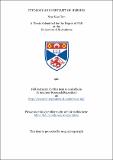Files in this item
Cytology and fertility of hybrids
Item metadata
| dc.contributor.advisor | Burnett, John Harrison | |
| dc.contributor.author | Tun, Nwe Nwe | |
| dc.coverage.spatial | 156 p. | en_US |
| dc.date.accessioned | 2018-06-08T14:07:28Z | |
| dc.date.available | 2018-06-08T14:07:28Z | |
| dc.date.issued | 1961 | |
| dc.identifier.uri | https://hdl.handle.net/10023/13855 | |
| dc.description.abstract | 1. Serial cytological observations were made on one abnormal seedling from the thornless segregants of the F2 progeny from crossing two tetraploid (2n=28) Rubus species. The number of root tip chromosomes was found to vary from 9 to 48 per cells, with the mode always at 35. The wide variation in chromosome number decreased with time, until at one point there was almost stability at 2n=35. 2. The number of satellites per cell was proportional to the number of nuoleoli per cell. Evidence from the number of satellites per cell suggests that different chromosomes were being involved in the different complements. 3. There was a correlation between the chromosome number and corresponding cell sizes within the aneuploid series. 4. Virus infection was not responsible for the variation of somatic chromosome numbers from cell to cell. 'The cause of the instability was not definitely located but it is suggested that its initiation arose from the egg sell as Rubus pollen is sensitive to chromosome unbalance. 5. Chromosome number instability of this plant is discussed in relation to other examples from the same and different genera. | en_US |
| dc.language.iso | en | en_US |
| dc.publisher | University of St Andrews | |
| dc.subject.lcc | QH423.T8 | en |
| dc.subject.lcsh | Plant hybridization | en |
| dc.title | Cytology and fertility of hybrids | en_US |
| dc.type | Thesis | en_US |
| dc.contributor.sponsor | Colombo Plan Traineeship Grant | en_US |
| dc.type.qualificationlevel | Doctoral | en_US |
| dc.type.qualificationname | PhD Doctor of Philosophy | en_US |
| dc.publisher.institution | The University of St Andrews | en_US |
This item appears in the following Collection(s)
Items in the St Andrews Research Repository are protected by copyright, with all rights reserved, unless otherwise indicated.

